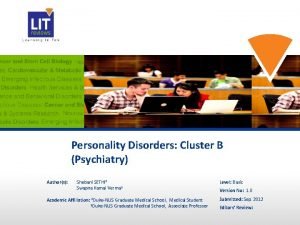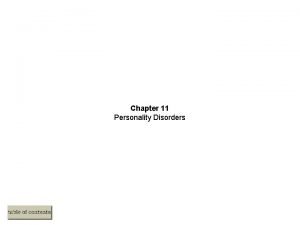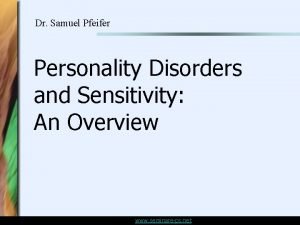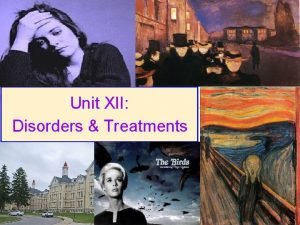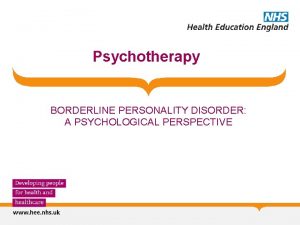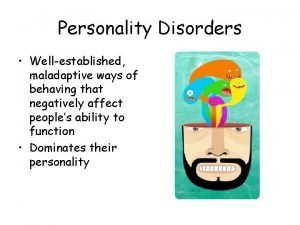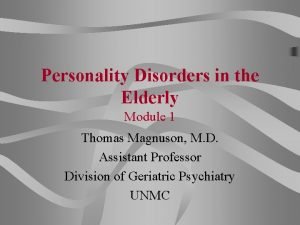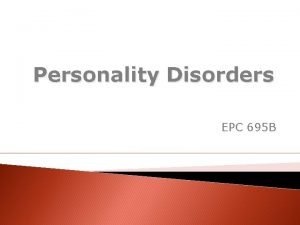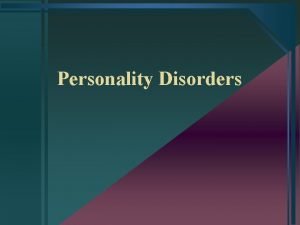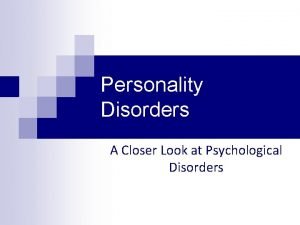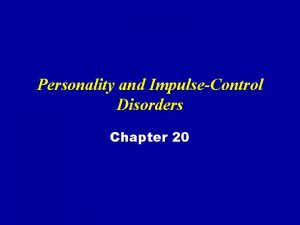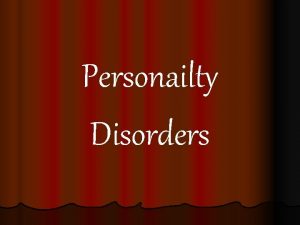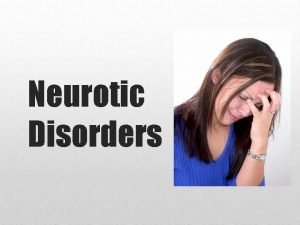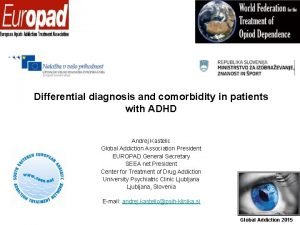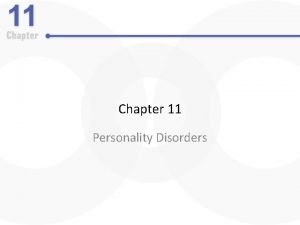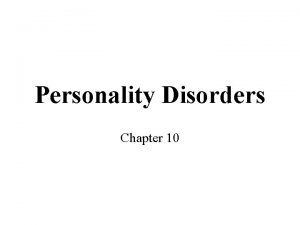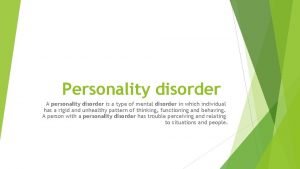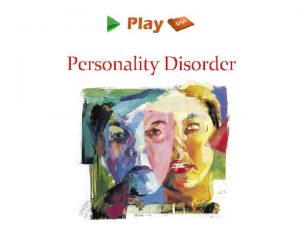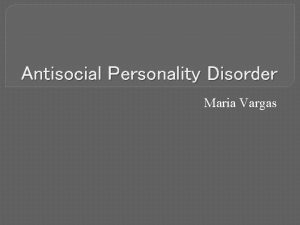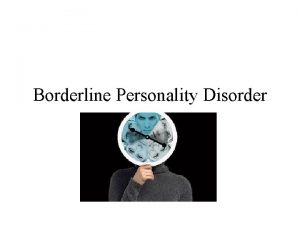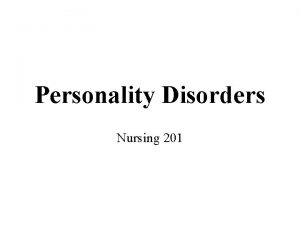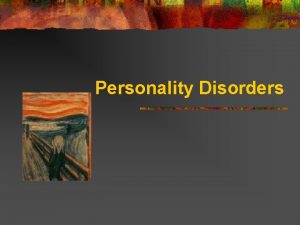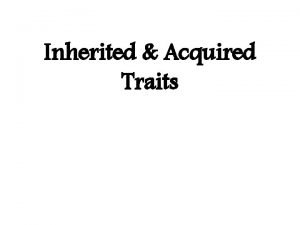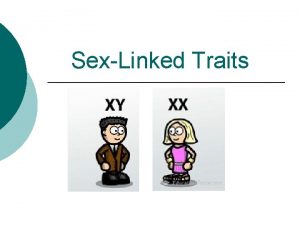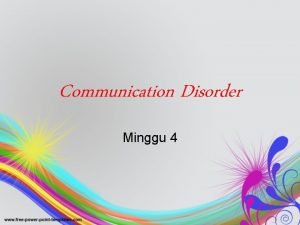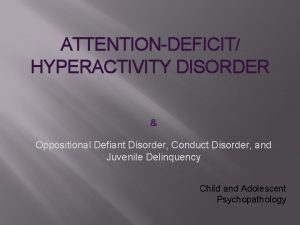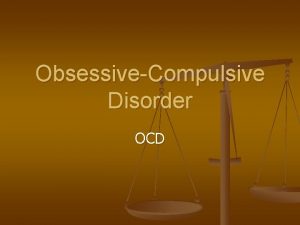CHAPTER 6 PERSONALITY DISORDER Traits of personality that






























- Slides: 30

CHAPTER 6 PERSONALITY DISORDER -Traits of personality that are not flexible & not adjusted so result is social or vocational failure or self-suffering. -Easier to observe sx at adolescence & continue for most of adulthood & less clear at middle age & elderly. -Dx should not be confirmed unless characteristics are applied for long period & not for specific period. -Usually pt. is unsatisfied because of effect of his behavior on others or unable to perform his work effectively. 1

Causes of personality disorders 1 -Biological factors a- Hereditary genes: Great similarity in personality among identical twins > un-identical twins. -Increasing in group (A) among relatives of persons with schizophrenia. b- Biochemical studies: Hyperactive persons have high average of testosterone that increase of aggression & sexual behavior. c- Nervous factors: Slight brain defect in childhood is connected with antisocial P. D. later. 2

2 -Psychoanalytic theory -Personality characteristics result from fixation on one stage of G & D stages. They are divided as: Oral personality: negative, dependent, eating food excessively. Anal personality: crucial, ungenerous, accurate & hard-headed. Obsessive personality: stiff & superego is dominating. Narcissistic personality: aggressive & self-centered. 3

3 -Social & cultural factors -Rxn b/w mood of child & father or mother during rearing is very important. Example: anxious child who is cared by anxious mother is susceptible more for P. D. than child with calm mother. *Cultures that increase & encourage aggression, is preparing for paranoid or antisocial P. D. 4

Classification of personality disorders There are 3 clusters: Cluster A: Paranoid, schizoid & schizotypal (odd and /or eccentric). -May be present on the same individual with psychotic disorders. Cluster B: Antisocial, borderline, histrionic & narcissistic (dramatic & emotional). -Often co-morbid with affective disorders. Cluster C: Avoidant, dependent, & obsessive-compulsive (anxious & fearful cluster). 5

Cluster (A) P. D. (odd/ eccentric) 1)Paranoid Personality Disorder: Epidemiology -Increased in families having 1 or > members dxed with paranoid personality disorder. -Males > females. -Substance abuse is common. 6

Sx -Distrust, suspicion -Difficulty adjusting to change -Sensitivity, argument -Feeling of irreversible injury by others-often without evidence -Anxiety, difficulty relaxing -Short temper -Lack of tender feelings toward others -Unwillingness to forgive even minor events -Jealousy of spouse or significant other-often without evidences 7

Prognosis -Starts at adulthood & may continue for end of pt. 's life. -In some cases disorder severity decrease by age. -Rarely that pt. is seeking for Rx & many problems appear in his relation with authority or people around him. Rx -Psychotherapy is Rx of choice & therapist should recognize that areas of trust, love, tolerance: disturbed. -Group psychotherapy is not appropriate. -Drugs may be used esp. in case of anxiety or agitation. 8

2)Schizoid Personality Disorder: Epidemiology -Males > females. -Increased prevalence in families with members who have schizophrenia or schizotypal P. D. Sx -Lack of desires to socialize; enjoys solitude -Lacks strong emotions -Detached, self-absorbed affect -Lacks trust in others -Brief psychotic episodes in response to stressful events -Difficulty expressing anger -Passive rxns to crisis 9

Prognosis -Starts in childhood & stays long period; not necessarily for life. -There is unknown percentage converted to schizophrenia. -Limitation in social r/s & vocational performance. -May be able to increase vocational performance in situations that need scientific achievement in socially separated conditions. Rx -Similar to Rx of paranoid P. D. but pt. with paranoid PD agrees with expectations of therapist through seeing self from inside but exaggerates in fantasy. -Group psychotherapy: useful; allows to communicate others. 10

3)Schizotypal Personality Disorder Epidemiology -30%-50% also have major depression. -Pts. seek Rx for anxiety &/or depression, not for P. D. features. -First-degree relatives of pts. with schizophrenia are at increased risk. -Males > females. -Pt. has deep & strange thinking style, appearance, behavior, limitation in r/s with others, but not enough to dx schizophrenia. 11

Sx -Incorrect interpretation of external events/ belief that all events refer to self. -Superstition, preoccupation with paranormal phenomena. -Belief in possession of magical control over others. -Constricted or inappropriate affect. -Anxiety in social situation. Prognosis -10% have suicide & some convert to schizophrenia. -Many can marry & work despite of their strange nature. 12

Cluster “B” P. D. (Dramatic & Emotional) 4) Antisocial Personality Disorder: Epidemiology -Usually dxed by year 18. -Have Hx of conduct disorders before age 15. -Males > females. -High percentage of dxed pts. are in substance abuse Rx settings, & prisons. -> in lower socioeconomic classes. -Substance abuse is common. -Impulsive behavior is common. 13

Sx: -Irresponsibility -Failure to honor financial obligations, plan ahead, provide children with basic needs -Involvement in illegal activities -Lack of quilt -Difficulty learning from mistakes -Initial charm dissolves to coldness, manipulation, blaming others -Lacks empathy -Irritability -Abuse of substances 14

Prognosis -Beginning in childhood: disturbance in behavior; among boys: childhood, among girls: adolescence. -Bad behavior of pts. may decrease after 30. -Failure in academic achievement, getting injury or die as a result of his/her disturbed behavior. -If did not appear in childhood, he/she can succeed academically, politically or economically. -Using work for his benefit & no consideration for values ethics & without blaming self or taking into consideration benefit of community. 15

Rx -Before starting Rx, therapist should find method to stop self-destructive behavior of pt. & his fear of intimacy & friendship with others & convincing him to communicate with others without fear of pain result from this communication or rxn. -Most useful method is group composed for their help & empathy with them & providing emotions they lost. -Meds. for anxiety or depression if found. 16

5)Borderline Personality Disorder: Epidemiology -75% are female. -Have Hx of physical & sexual abuse, neglect, hostile, conflict & early parental losses or separation. 17

Sx -Intense, stormy relationships -Sees people as “all good” or “all bad” -Impulsivity -Self mutilation -Difficulty identifying self -Negative & angry affect -Feelings of emptiness & boredom -Difficulty being alone, feeling of abandonment -Has impulsive acts (binging, spending money) -Suicidal ideation 18

Prognosis -Starts early in adulthood & characterized by instability. -Doesn’t convert to schizophrenia but to major depression & sometimes to brief psychotic disorder. -Most dangerous complication is suicide. Rx -Psychotherapy is Rx of choice in addition to drugs. -Psychotherapy is considered difficult subject for therapist & pt. since pt. tends to practice regression & fluctuating feelings toward therapist. -Drugs include anti-psychotic, anti-depression, anti-anxiety, & sometimes anti-convulsion. 19

6) Histrionic personality disorder: Epidemiology -Females > males. Sx -Fluctuation in emotions -Attention-seeking, self-centered attitude -Sexual seduction -Attentiveness to own physical appearance -Dramatic, impressionistic speech style -Vague logic-lack of conviction in arguments, often switching sides -Shallow emotional expression -Craving for immediate satisfaction -Complaints of physical illness, somatization -Use of suicidal gestures and threats to get attention 20

Prognosis - Appears in early adulthood & sx decrease by age. -Often relation of pt. with others are affected & disturbed. -Brief psychotic disorder, hysterical conversion, somatization may occur. Rx -Often pt. doesn’t recognize his real feeling so clarifying them to pt. is important step in Rx. -Drugs maybe used if sever anxiety or depression. 21

7) Narcissistic personality disorder: Epidemiology -Males > females. Sx -Grandiose view of self. -Lacks empathy toward others. -Needs for admiration. -Preoccupation with fantasies of success, brilliance, beauty, ideal love. 22

Prognosis -Starts in early adulthood mainly chronic. -Disturbance in their social r/s, difficulties with others, & unrealistic goals. Rx -Difficult to be treated & need long-term psychoanalysis to establish change. 23

Cluster “C” P. D. (Anxious & Fearful) 8)Avoidant Personality Disorder: Epidemiology -Males equals females. Sx -Fearful of criticism, disapproval, or rejection -Avoid social interactions -Withhold thoughts or feelings -Negative sense of self, low self-esteem 24

Prognosis -Starts in early adulthood & can work in socially comfortable situation. -Some may have depression, anxiety, anger or social phobia. Rx -Depends on acceptance of therapist to fears of pt. & stability of therapeutic r/s & encouraging him to communicate with outside world but carefully in order not to have any failure that may support original opinion of pt. -Group psychotherapy may help these pts. -Training on self-confidence is behavioral method to teach pt. how to express feeling & needs & improve self-esteem. 25

9) Dependent Personality Disorder Epidemiology -Females > males. -Sx are demonstrated early in life. -Children or adolescents with chronic physical illness or separation anxiety disorder may be predisposed. Sx -Submissive, clinging -Unable to make decisions by themselves -Can’t express negative feelings (emotions) -Difficulty following through on tasks 26

Prognosis -Appears in early adulthood & weakness in field of work achievement because of passivity. -Some pts. become addict or depressed or other psychiatric disorders. -Little will live without psychiatric disorders. Rx -Supportive psychotherapy is useful & taking into consideration internal passive aggression of pt. -Giving anti-depression if needed. 27

10) Obsessive-Compulsive Personality Disorder Epidemiology -Males are twice > females. Sx -Preoccupation with perfection, organization, structure, control -Procrastination -Abandonment of projects due to dissatisfaction -Difficulty relaxing -Rule-conscious behavior 28

-Self-criticism with inability to forgive own errors -Reluctance to delegate -Inability to discard anything -Insistence on other’s conforming to own methods -Rejection to praise -Reluctance to spend money -Background of stiff & formal r/s -Preoccupation with logic & intellect 29

Prognosis -Starts in early adulthood. -May have obsessive-compulsives disorder, schizophrenia or depression or hypochondriasis. -May become adjusted with his condition. Rx -Pt. has insight & seeking for Rx to relief their suffering. -Long-term psychoanalytic is useful. -Behavior & group psychotherapy is less useful. -Some drugs maybe added symptomatically. 30
 Cluster traits
Cluster traits Borderline personality disorder mnemonic
Borderline personality disorder mnemonic Traits of avoidant personality disorder
Traits of avoidant personality disorder Factitious disorder
Factitious disorder Ngoại tâm thu thất chùm đôi
Ngoại tâm thu thất chùm đôi Block nhĩ thất độ 2 type 1
Block nhĩ thất độ 2 type 1 Thể thơ truyền thống
Thể thơ truyền thống Thơ thất ngôn tứ tuyệt đường luật
Thơ thất ngôn tứ tuyệt đường luật Walmart thất bại ở nhật
Walmart thất bại ở nhật Tìm độ lớn thật của tam giác abc
Tìm độ lớn thật của tam giác abc Con hãy đưa tay khi thấy người vấp ngã
Con hãy đưa tay khi thấy người vấp ngã Tôn thất thuyết là ai
Tôn thất thuyết là ai Gây tê cơ vuông thắt lưng
Gây tê cơ vuông thắt lưng Sau thất bại ở hồ điển triệt
Sau thất bại ở hồ điển triệt Schizoid personality disorder
Schizoid personality disorder Bpd comorbidity
Bpd comorbidity Emotionally unstable personality disorder
Emotionally unstable personality disorder Antisocial personality disorder cluster
Antisocial personality disorder cluster Psychopath vs. sociopath chart
Psychopath vs. sociopath chart Cluster c
Cluster c Nos personality disorder
Nos personality disorder Personality trait disorder
Personality trait disorder Paranoid personality disorder
Paranoid personality disorder Antisocial personality disorder nursing interventions
Antisocial personality disorder nursing interventions Enduring pattern meaning
Enduring pattern meaning Neurotic stress-related and somatoform disorders
Neurotic stress-related and somatoform disorders What causes a narcissist
What causes a narcissist Neurotic need for affection and approval
Neurotic need for affection and approval Adhd vs bipolar
Adhd vs bipolar Personality disorder vs mental illness
Personality disorder vs mental illness Cluster b personality disorder
Cluster b personality disorder
